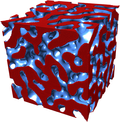Subproject A.6
Simulation of manufacture of open-porous solids
Manufacturing of open-porous functional materials
 The aim of the project is the development and testing of a particle-based simulation method by which the preparation of porous materials can be simulated and the formation of porous structures can be computationally optimized. Typical characteristics of the morphology formation in mesoscale range are formation and temporal changes of irregular phase boundaries that are in contact with fluid phases in the energy and material. As examples of such processes, the precipitation of porous membranes from an initially homogeneous polymer solution or the degeneration flow through a layer of soot may be mentioned by oxidation with oxygen in the particulate filter of a vehicle. The software package is designed to enable all this relevant physical and chemical processes of structure formation map.
The aim of the project is the development and testing of a particle-based simulation method by which the preparation of porous materials can be simulated and the formation of porous structures can be computationally optimized. Typical characteristics of the morphology formation in mesoscale range are formation and temporal changes of irregular phase boundaries that are in contact with fluid phases in the energy and material. As examples of such processes, the precipitation of porous membranes from an initially homogeneous polymer solution or the degeneration flow through a layer of soot may be mentioned by oxidation with oxygen in the particulate filter of a vehicle. The software package is designed to enable all this relevant physical and chemical processes of structure formation map.
Due to the complex and dynamically changing geometry the grid-free "Smoothed Particle Hydrodynamics" method (SPH) is selected. The 2D code has been parallelized and successfully extended to 3D calculations. Now the transition from generic examples is extended to two practical problems which are the membrane precipitation and regeneration of particulate filters. This requires that the code has to be further improved, both in terms of physical phenomena and computational efficiency. Intended are the calculation of thermodynamic data with the PC-SAFT equation of state, the modeling of armophen solidification of the polymer-rich phase and the approximation of the fluid flow as a Stokes flow. For increasing the efficiency SPH is coupled to established, grid-based methods.
Further information about this subproject

